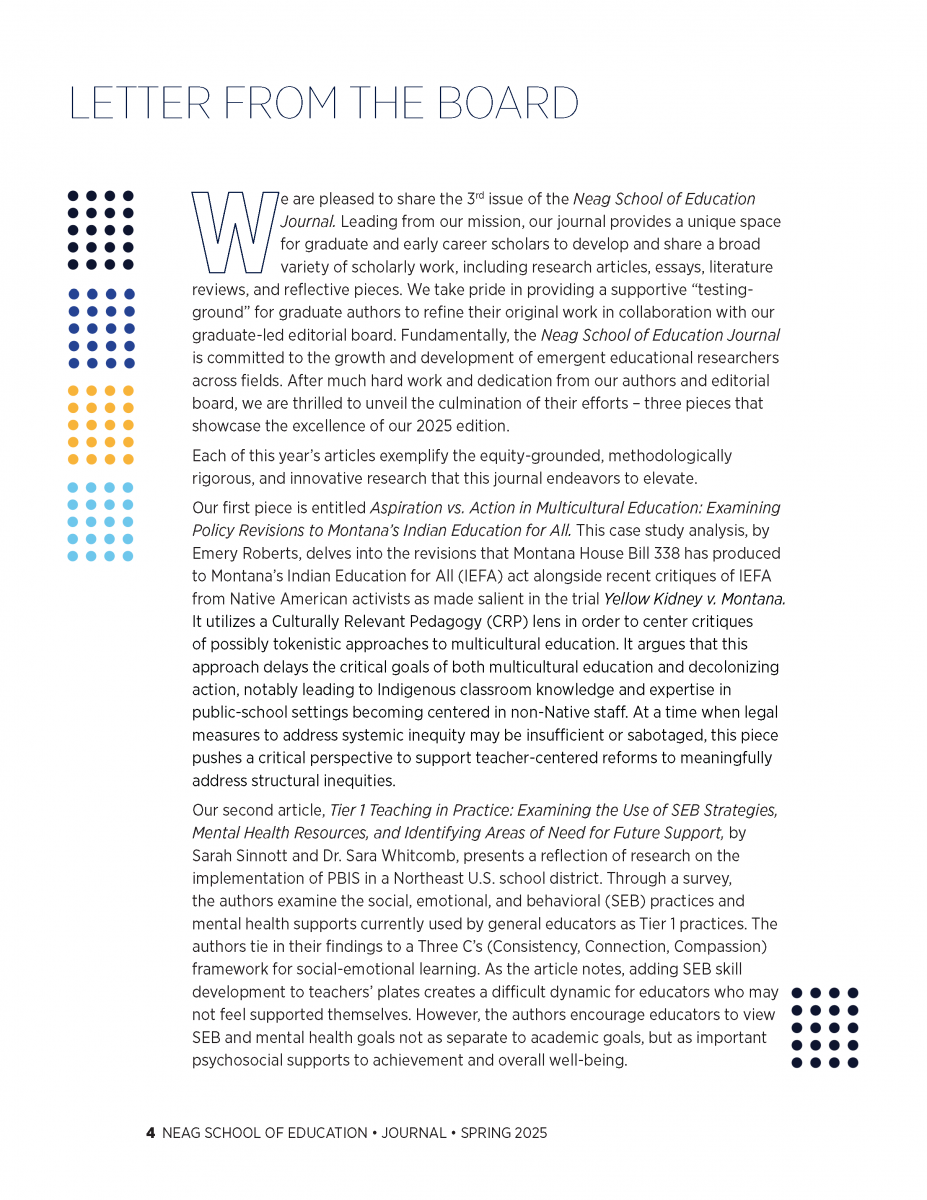We are pleased to share the 3rd issue of the Neag School of Education Journal. Leading from our mission, our journal provides a unique space for graduate and early career scholars to develop and share a broad variety of scholarly work, including research articles, essays, literature reviews, and reflective pieces. We take pride in providing a supportive “testing-ground” for graduate authors to refine their original work in collaboration with our graduate-led editorial board. Fundamentally, the Neag School of Education Journal is committed to the growth and development of emergent educational researchers across fields. After much hard work and dedication from our authors and editorial board, we are thrilled to unveil the culmination of their efforts – three pieces that showcase the excellence of our 2025 edition.
Each of this year’s articles exemplify the equity-grounded, methodologically rigorous, and innovative research that this journal endeavors to elevate.
Our first piece is entitled Aspiration vs. Action in Multicultural Education: Examining Policy Revisions to Montana’s Indian Education for All. This case study analysis, by Emery Roberts, delves into the revisions that Montana House Bill 338 has produced to Montana’s Indian Education for All (IEFA) act alongside recent critiques of IEFA from Native American activists as made salient in the trial Yellow Kidney v. Montana. It utilizes a Culturally Relevant Pedagogy (CRP) lens in order to center critiques of possibly tokenistic approaches to multicultural education. It argues that this approach delays the critical goals of both multicultural education and decolonizing action, notably leading to Indigenous classroom knowledge and expertise in public-school settings becoming centered in non-Native staff. At a time when legal measures to address systemic inequity may be insufficient or sabotaged, this piece pushes a critical perspective to support teacher-centered reforms to meaningfully address structural inequities.
Our second article, Tier 1 Teaching in Practice: Examining the Use of SEB Strategies, Mental Health Resources, and Identifying Areas of Need for Future Support, by Sarah Sinnott and Dr. Sara Whitcomb, presents a reflection of research on the implementation of PBIS in a Northeast U.S. school district. Through a survey, the authors examine the social, emotional, and behavioral (SEB) practices and mental health supports currently used by general educators as Tier 1 practices. The authors tie in their findings to a Three C’s (Consistency, Connection, Compassion) framework for social-emotional learning. As the article notes, adding SEB skill development to teachers’ plates creates a difficult dynamic for educators who may not feel supported themselves. However, the authors encourage educators to view SEB and mental health goals not as separate to academic goals, but as important psychosocial supports to achievement and overall well-being.
Finally – Not Your Standard English Languages Arts Classroom: Critical Language Awareness Pedagogies in Secondary English, by Faith Thompson. This essay explores the historical context of linguistic racism in secondary English and Language Arts (ELA) classrooms through the lens of Critical Language Awareness (CLA) pedagogies. The piece dives into the literature around this topic, particularly concerning antiBlack cultural mismatch as manifested through linguistic racism targeting African American English (AAE). It examines and categorizes the literature on the intersection of this issue in ELA classrooms and argues for the critical need to mitigate the cultural and linguistic mismatch between racialized students and the majority white teaching force. In the modern context of ongoing systemic inequity for historically marginalized students, this piece serves as an important examination of existing literature and a call to expand the field going forward.
We look forward to your enjoyment of this issue’s work and the outstanding contributions from our graduate and early career authors. We further hope that authors use the feedback they received during the editing process and choose to publish these manuscripts in professional peer reviewed journals in the future. At the Neag School of Education Journal, we focus on the development of student work by employing a high-dose, collaborative review process. Our novel copyright policy is designed to empower students and early career scholars, allowing them to maintain the copyright for future publication.
We have many fantastic and dedicated people to thank for the realization of our 3rd issue. To Dr. Jennie Weiner, our advisor, thank you for your tireless dedication to this journal and to students. You model to us what a human-centered and compassionate review process can be and have taught us enduring lessons as reviewers and researchers. Another thank you to Dr. Jason Irizarry, our dean, who has enthusiastically supported the journal from its inception and made it clear that our work and voices matter.
Thank you to Shawn Kornegay and the design team at UConn who helped ensure a third issue as beautifully apportioned as the first. We look forward to continuing to uplift graduate students’ work in years to come.
Thank you to the members of the journal whose hard work and enthusiasm made this issue possible. We are excited to continue advancing this work with your assistance going forward.
Finally, thank you to the authors of the pieces featured in this issue and all who submitted work. It goes without saying that this would be impossible without your contributions. We are immensely proud to feature your work in this issue.
To learn more about our team and mission, please visit us at https://education.uconn.edu/neag-journal/

